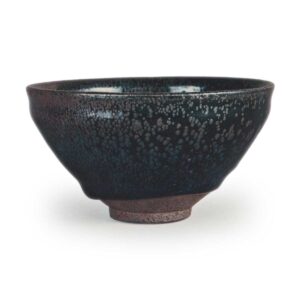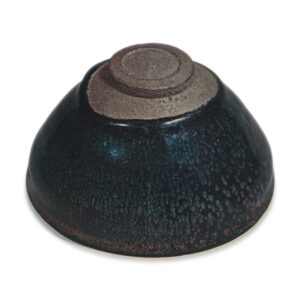

Nezu Museum
Height: 6.6cm
Diameter: 12.1cm
Foot diameter: 3.8cm
Height: 0.5cm
Although it is known as a Yohen Tenmoku, today it is thought to be a type of Yuhitsu.
The shape is correct, and the hard, slightly rough clay, which contains a large amount of iron, is also characteristic of Tenmoku. The thick black glaze on the inside and outside is almost cut off at the waist of the outside. The glaze flows and becomes thin around the rim, and also takes on a reddish hue. As it thickens towards the bottom, it also takes on a bluish hue, and collects in large pools in the areas where the glaze has broken.
There are countless oil droplets on the entire surface of the glaze, but they appear sparsely on the outside and densely on the inside, with some areas having a wavy pattern. The inside is generally dense, and there are also areas that have a wavy pattern. From this, we can see that there is a very close relationship between wavy patterns and oil droplets.
The characteristics of this tenmoku tea bowl do not end there. A bluish-purple metallic luster appears across the entire surface of the glaze, and this is particularly noticeable on the inside. On the outside, too, a strong bluish color appears on the lower half, creating a unique style. The reason for this phenomenon is not known, but it is thought that a very thin film forms on the surface of the glaze, and this shines like a rainbow due to interference of light. This phenomenon is rare in Kenzan, and although there is always some such luster in other Yudeki Tenmoku, clear examples like this tea bowl are rare. It is thought that the reason it has been called Yohen since ancient times is due to this unique luster. Of course, at present, this is not enough to call this tea bowl Yohen. If you interpret yohen as being synonymous with yohen, then this is also a type of yohen. However, it is more correctly an oil spot tenmoku, and it is a rare example of a tenmoku tea bowl that is similar to a rabbit hair bowl in some respects, and also has a luster similar to the yohen phenomenon. The shape and workmanship are both extremely elegant, and it goes without saying that it is an outstanding masterpiece among the Jian ware. There is one place where the rim has been repaired.
It is thought to have been made at the Jian kilns in Fujian Province around the 13th century.
It was originally in the Maeda family, and was acquired by Kaichiro Nezu and placed in the Nezu Museum. In 1936, it was designated as an Important Art Object.
The accessories are a single bag with a gold-lacquered trellis design and a single black lacquered Tenmoku stand. The inside of the box lid is silver-lacquered. The ground is decorated with gold powder in the shape of characters, and it is inscribed with the name of Kosho Kobori, the calligrapher, and the seal of the calligrapher.
(Hasebe Gakuji)



